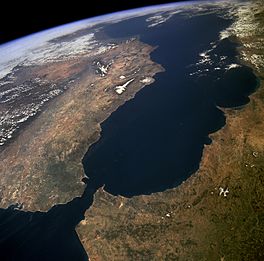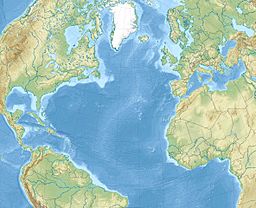Strait of Gibraltar facts for kids
Quick facts for kids Strait of Gibraltar |
|
|---|---|

The Strait of Gibraltar as seen from space.
The Iberian Peninsula is on the left and North Africa is on the right. |
|
| Location | Atlantic Ocean – Mediterranean Sea |
| Coordinates | 35°58′N 5°29′W / 35.967°N 5.483°W |
| Type | Strait |
| Native name | |
| Basin countries | |
| Min. width | 13 km (8.1 mi) |
| Max. depth | 900 metres (2,953 ft) |
The Strait of Gibraltar is a narrow waterway. It connects the Atlantic Ocean to the Mediterranean Sea. This strait also separates two continents. On one side is Europe, with Gibraltar and Spain. On the other side is Africa, home to Morocco.
At its narrowest point, the Strait is about 14.3 kilometers (8.9 miles) wide. The water here is quite deep, ranging from 300 to 900 meters (980 to 2,950 feet). Long ago, about 20,000 years ago, the sea level was much lower. It was about 110 to 120 meters (360 to 390 feet) lower than today. Ferries travel across the Strait every day. A trip can take as little as 35 minutes. Part of the Spanish side of the Strait is a protected area. It is called El Estrecho Natural Park.
Contents
A Bridge Between Continents
The Strait of Gibraltar is like a natural bridge. It links two huge bodies of water. It also connects two different continents. This makes it a very important place for ships. Many ships use this route for trade and travel.
Location and Geography
The Strait is located at the southern tip of the Iberian Peninsula. This is where Europe almost touches Africa. The land on both sides is very rocky. There are tall cliffs and hills. These features make the Strait easy to spot from above.
Water Flow and Currents
Water flows in and out of the Strait constantly. The Atlantic Ocean has cooler, less salty water. The Mediterranean Sea has warmer, saltier water. This difference creates strong currents. Water from the Atlantic flows into the Mediterranean near the surface. Deeper down, saltier water from the Mediterranean flows back into the Atlantic. This constant exchange helps keep the Mediterranean Sea healthy.
Marine Life in the Strait
The Strait of Gibraltar is home to many sea creatures. Different types of fish, dolphins, and whales live here. The strong currents bring lots of food. This makes it a rich environment for marine life. It is also a key migration route for many species.
History and Importance
For thousands of years, the Strait has been important. Ancient civilizations knew about it. They called the two large rocks on either side the "Pillars of Hercules." These pillars marked the edge of the known world for many people.
A Busy Shipping Lane
Today, the Strait is one of the busiest shipping lanes. Thousands of ships pass through it every year. They carry goods and people between the Atlantic and the Mediterranean. This makes it vital for global trade. It is also important for military and naval operations.
Natural Park Protection
The Spanish side of the Strait is protected. El Estrecho Natural Park helps preserve its natural beauty. It also protects the diverse wildlife. This park is a great place to see birds migrating. Many birds cross the Strait between Europe and Africa.
Images for kids
-
Historic map of the Strait of Gibraltar by Piri Reis.
See also
 In Spanish: Estrecho de Gibraltar para niños
In Spanish: Estrecho de Gibraltar para niños








